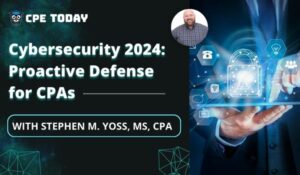
Major Topics
Learning Objectives
- Recognize a client’s potential use of the S corporation format and its tax advantages and disadvantages by citing the requirements for an S corporation election, identifying eligible S corporation shareholders, specifying the one-class-of-stock regulations, and determining the ways an S corporation election can be terminated.
- Identify the concepts of S corporation taxation by: a. Recognizing the application of passive income taxation, accumulated adjustments accounts, built-in gains, net operating losses, tax preference items, and potential capital gains taxes, b. Determining a shareholder’s stock basis from capitalization and loan activity, c. Specifying the related party rules including their impact on deductions, available fringe benefits, and tax forms to use when filing as an S corporation.
Course Description
In this course, the intricacies of setting up and terminating an S corporation are detailed and taxation is discussed. The numerous advantages and disadvantages of this entity are identified to help practitioners determine whether the S corporation is most suitable for their clients. Eligible domestic corporations can avoid double taxation by electing to be treated as an S corporation under the rules of Subchapter S. Subchapter S provides an optional method of corporate taxation and allows small business corporations to elect unusual tax treatment. The S corporation is taxed like a partnership, but in other respects, S corporations are taxed like C corporations.
Compliance Information
Advanced Preparation
None
Field of Study
Taxes
Credits
3 Credits
Published Date
February 2, 2023
Revision Date
April 1, 2024Course Authors
Danny Santucci
Danny earned his Bachelor of Arts in Political Science from the University of California at Irvine in 1969. He received his Juris Doctorate from Boalt Hall School of Law, University of California at Berkeley in 1972, at which time he began practice as a tax attorney in Southern California. His legal career started with the business and litigation firm of Edwards, Edwards, and Ashton. Later he joined the Century City entertainment firm of Bushkin, Gaims, Gaines & Jonas working for many well-known celebrities. In 1980, Danny established the law firm of Santucci, Potter, and Leanders, in Irvine, California. With increasing lecture and writing commitments, Danny went into sole practice in 1995. His practice emphasizes business taxation, real estate law, and estate planning.
Overview
In this course, the intricacies of setting up and terminating an S corporation are detailed and taxation is discussed. The numerous advantages and disadvantages of this entity are identified to help practitioners determine whether the S corporation is most suitable for their clients. Eligible domestic corporations can avoid double taxation by electing to be treated as an S corporation under the rules of Subchapter S. Subchapter S provides an optional method of corporate taxation and allows small business corporations to elect unusual tax treatment. The S corporation is taxed like a partnership, but in other respects, S corporations are taxed like C corporations.
Course Details
- Recognize a client’s potential use of the S corporation format and its tax advantages and disadvantages by citing the requirements for an S corporation election, identifying eligible S corporation shareholders, specifying the one-class-of-stock regulations, and determining the ways an S corporation election can be terminated.
- Identify the concepts of S corporation taxation by: a. Recognizing the application of passive income taxation, accumulated adjustments accounts, built-in gains, net operating losses, tax preference items, and potential capital gains taxes, b. Determining a shareholder’s stock basis from capitalization and loan activity, c. Specifying the related party rules including their impact on deductions, available fringe benefits, and tax forms to use when filing as an S corporation.
Intended Audience —
Advanced Preparation — None
Field of Study — Taxes
Credits — 3 Credits
IRS Program Number –
Published Date – February 2, 2023
Revision Date – April 1, 2024
Course Authors
Danny Santucci
Danny earned his Bachelor of Arts in Political Science from the University of California at Irvine in 1969. He received his Juris Doctorate from Boalt Hall School of Law, University of California at Berkeley in 1972, at which time he began practice as a tax attorney in Southern California. His legal career started with the business and litigation firm of Edwards, Edwards, and Ashton. Later he joined the Century City entertainment firm of Bushkin, Gaims, Gaines & Jonas working for many well-known celebrities. In 1980, Danny established the law firm of Santucci, Potter, and Leanders, in Irvine, California. With increasing lecture and writing commitments, Danny went into sole practice in 1995. His practice emphasizes business taxation, real estate law, and estate planning.
All of our self-study courses are NASBA approved (through our partners at K2 Enterprises) the revisions to the Statement on Standards for Continuing Professional Education (CPE) Programs (Standards).
Your Registration Includes:
- ✓ Course materials (video & PDF version)
- ✓ Unlimited attempts to complete exam
- ✓ Course materials (PDF & Sample Materials)
- ✓ Instant grading & certificate of completion
- ✓ One year access to complete your CPE
- ✓ Completion certificate



